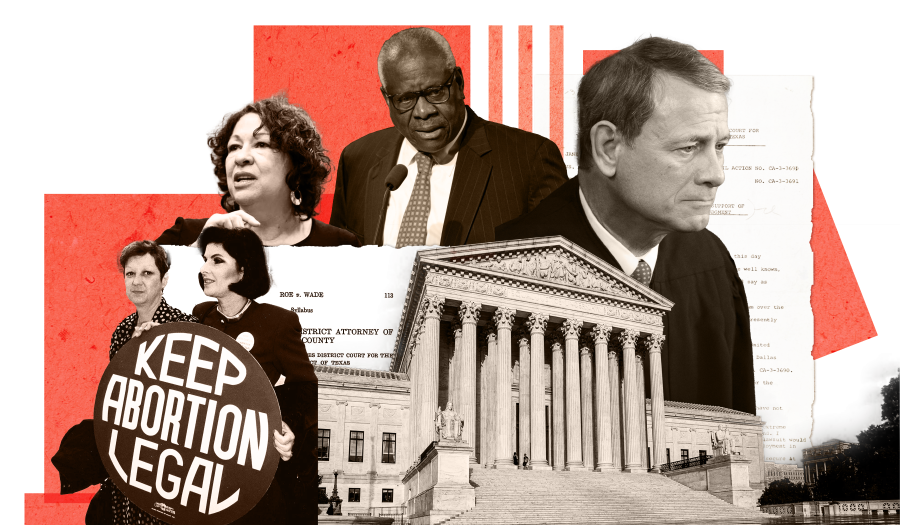The challenges to abortion rights are mounting, presenting an unclear future for Roe v. Wade going forward.
Since the Supreme Court case Roe v. Wade presented its landmark ruling pertaining to abortion in 1973, the pro-life movement has continued to protest and disagree with it. The case has continued to set the tone for abortion rights legislation in America.
Over the past few years, however, red states have attempted and started to institute more abortion restrictions. Two weeks ago, Florida banned abortions after 15 weeks, following Mississippi’s similar abortion ban.
The Mississippi and Florida abortion bans do not provide exemptions for rape, incest, or sexual trafficing — only for life-threatening emergencies.
Other states carry “near-total bans” on standby in case Mississippi wins their legal case over the abortion outlaw; these ban all abortions except “life threatening abortions.” Oklahoma has led the charge for this kind of ban, with 18 states instituting a similar kind of legislation.
Both of these types of abortion bans (limiting and near-total) are reopening the discussion about Roe v. Wade and its standing as a precedent.
The Supreme Court is currently reviewing Mississippi’s abortion law (which has failed at every lower level of court) and if overturned, could reverse the 50 year reign of Roe as the standard for abortion rights.
The decision about whether Roe will be overturned is expected to come within the next couple months. The state’s actions, with the rollout of so many anti-abortion laws, seem to indicate a potential overturning.
Jennifer Hendricks, Professor of Law at the University of Colorado Law School, published a study, based on precedent, about how far the court could go in an overruling of Roe.
“It’s safe to assume that six justices are inclined to repudiate Roe, and some of those six would like to go further, declaring a constitutional right to life that would prevent the abortion issue from going ‘back to the states’ at all,” Hendricks said. “One of the six, Chief Justice Roberts, is known to prefer stealth overruling of precedent, and he will likely convince at least one other member of the majority to overrule Roe carefully.”
With the conservative lean in the Supreme Court, the decision to strike down Roe could be down the line.
The aftermath of an overturning leaves uncertainty for the future of abortion rights. Marjorie Dannenfelser, president of the Susan B. Anthony List, addresses the muddied future of abortion rights in each state.
“But that’s what consensus is, it’s the consensus of people living in [each] state,” List told NPR. “So it will be different in Alabama than in North Carolina, which will be different from the state of Washington, from Texas.”
In each state court, officials can create different standards and precedents for the set state. The governor of Michigan, for example, has already stated their desire for state courts to allow abortions. The way courts lean, whether Democratic or Republican, will ultimately allow for the laws to be enacted.
The Supreme Court currently leans conservative, even with the introduction of Justice Kentanji Brown Jackson, a progressive judge. Professor Hendricks assumes the end goal is more than just allowing for a pathway for abortion. The overall official outcome of a post-Roe abortion landscape may result in abortion potentially becoming illegal all over the United States.
“The end-game here is not just to overrule Roe in the sense many people continue to naively assume, where abortion gets ‘sent back to the states,” Hendricks published. “The trajectory of this argument is not just to overrule Roe but to establish a right to life for the fetus, superior to the rights of the pregnant woman, not through a constitutional amendment but through a Supreme Court decision, so that the Supreme Court would rule not just that abortion is unprotected but that it is, in fact, constitutionally prohibited everywhere in the U.S.”
The ramifications of abortion restrictions extend into health care procedures as well. The hesitation over procedures or coverage could result in potential health complications for some women. Breana Lipscomb, senior advisor for Maternal Health & Rights at the Center for Reproductive Rights, further highlights overarching health complications for pregnant women.
“Pregnant people themselves may hesitate to seek health care services for miscarriages or obstetric emergencies out of fear that they will be criminalized or punished,” Lipscomb said. “With abortion services restricted or banned, pregnant people experiencing complications or pregnancy losses may be forced to travel long distances and even across multiple state lines just to access appropriate care.”
The number of abortions happenings are going down, leading to more struggles to find a place still doing abortions. Planned Parenthood, one of the leaders in reproductive safety, are struggling with the abortions among the southern states.
“The Deep South is one of the most difficult regions to find a provider to work in, and we understand how very lucky we are to have someone local to provide abortions five days a week,” Marty told Jezebel. “This discontinuation of abortion services has definitely impacted our own staff — who have already been working extra hours to meet the influx of Mississippi, Louisiana, and Texas patients — and are now adding these patients who have had their previously-booked Planned Parenthood appointments canceled on them.”
If overturned, women face uncertainty about what procedures and steps are allowed during pregnancy. This lack of clarity can cause complications for pregnant women due to the pause over whether the hospital is able to operate, especially if what is life threatening is unclear. Gray area over what necessitates the removal of a fetus provides more questions than answers.
“People should be able to access essential healthcare and make deeply-personal decisions about their health and their families free from political interference,” Lipscomb said. “Access to reproductive healthcare — whether abortion care or maternal healthcare — is critical for societies to prosper and thrive. Everyone, everywhere deserves the right to decide what is best for their bodies and health.”
Much of the abortion landscape remains unclear, but the future of Roe lies in the hands of the Supreme Court. Given all of the indications, Roe v. Wade’s position as the landmark case is under jeopardy. The Court will announce the outcome in a few months, but the battle over abortion rights is far from over. The Mississippi case is only the beginning.
Art by Nicholis Regli for the UCSD Guardian.














thomas thomas111 • Jun 30, 2022 at 9:06 pm
Your email address will not be published. Required fields are marked *
Comment